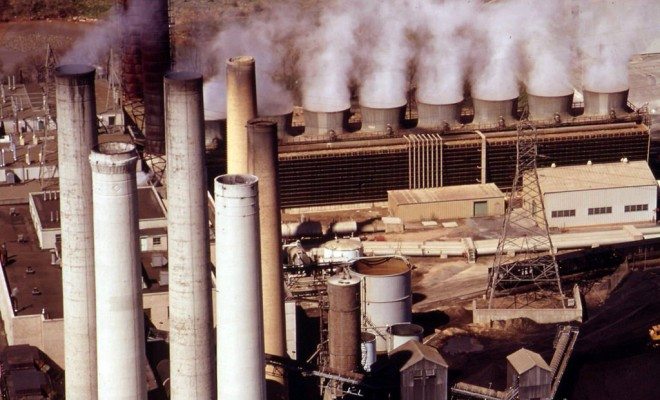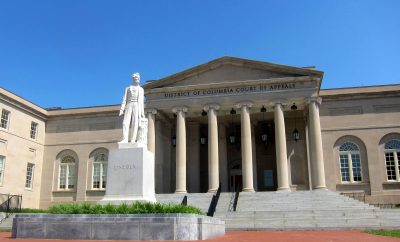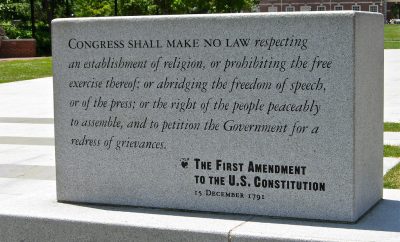 "Coal-Burning Power Plant" courtesy of [Stuart Rankin via Flickr]
"Coal-Burning Power Plant" courtesy of [Stuart Rankin via Flickr]
Energy & Environment
Will the United States be Able to Keep its Paris Agreement Commitments?
The United States for the first time in history promised to cut its carbon dioxide emissions when it joined the Paris Agreement. In order to meet those targets, the Obama Administration created the Clean Power Plan to reduce emissions and move American states toward cleaner energy sources. However, the Clean Power Plan is currently being challenged in the Supreme Court and it’s unclear whether or not the U.S. government will be able to make its promises a reality. Read on to learn more about the past, present, and potential future of federal pollution regulation in the United States.
The Current Political Context
Currently, the United States has the second highest rate of carbon dioxide emissions in the world, surpassed only by China. The United States has also historically avoided participating in international climate negotiations and is one of a small number of developed nations that chose not to ratify the Kyoto Convention. While both industrialized and developing countries around the world have joined onto the convention over the past two decades and made pledges to reduce their emissions, the United States has struggled to make national commitments to reduce its own emissions. This is, in part, because American fossil fuel companies have been able to exert a great deal of influence on political decisions through lobbying and because Congress is divided on whether or not climate change is even scientifically valid.
COP21, the 21st Conference of Parties for the U.N. Framework Convention on Climate Change, marked the first time that the United States made a national pledge to reduce its emissions. However, while the COP21 was hailed as an international victory, it remains unclear if America can actually follow through on its commitments. U.S. policymakers remain divided on the issue of climate change and many believe that the government’s attempts to regulate fossil fuel usage directly interfere with the economy. As of February, the Clean Power Plan, with which the EPA began strictly regulating CO2 emissions from power plants, has been stayed by the Supreme Court and risks being ruled unconstitutional. The United States may have made an international commitment to reduce emissions, but on a domestic level, is it ready for such a change to take place?
A Brief history of Climate Change Negotiations
The first United Nations Framework Convention on Climate Change, also known as the Kyoto Protocol, was held on December 11, 1997. The convention entered into force on February 16, 2005–90 days after it was ratified by 55 nations emitting at least 55 percent of the CO2 emissions in 1990. The protocol required industrialized countries to make pledges to reduce their emissions by 5 percent before 2012.
Developing nations weren’t required to make pledges in the first incarnation of the Kyoto Protocol, although many did pledge to use aid from the U.N. and World Bank to invest in renewable energy sources. This was decided by the principle of “common but differentiated responsibilities,” meaning that since industrialized countries did the most damage to the environment, they should bear the heaviest burden of fixing it. Likewise, since dramatically reducing emissions would handicap growth in developing nations, it’s viewed as unfair to expect them to make the same level of commitment.
The United States did sign onto the Kyoto Protocol but it did not ratify the convention, meaning essentially that it gave its public support but refused to individually reduce its emissions. Decisions not to make emissions pledges from some major nations such as the United States, Canada, and Russia–although Russia did eventually agree to ratify the convention in 2004–are often cited by smaller countries as justification to not participate as well.

“High-level ministerial roundtable under the Kyoto Protocol” courtesy of UNclimatechange via Flickr
In 2012, following the end of the Kyoto Protocol’s first commitment period, another conference was held to establish new international pledges. The second conference produced the Doha Amendment, which gathered binding emissions reduction commitments from much of the industrialized world, including the entirety of the European Union and 37 other developed countries. Many developing countries ratified the amendment and made their own commitments, but their participation was on a non-binding basis.
In December 2015, COP21 was held in Paris and attended by representatives from 188 different countries, making it one of the largest international conferences in history. Rather than set specific reduction targets, COP21 let each participating country decide its own emission reduction plan with the ultimate goal of keeping global warming from raising the earth’s temperature by more than 2 degrees Celsius. COP21 was successful in bringing together almost every country on earth to participate in the conference, including a wide range of developing countries and many of the world’s top polluters, such as China, India, Indonesia, and the United States. The United States pledged to reduce its emissions between 26 and 28 percent by 2025, focusing primarily on carbon dioxide but also on methane, nitrous oxide, perfluorocarbons, sulfur hexafluoride, and nitrogen trifluoride.
The Clean Air Act and the EPA’s Role in Emissions Regulations
While COP21 marks the first time that the United States made an international commitment to reduce its emissions, the U.S. government has exercised power internally to regulate emissions since Congress passed the Clean Air Act in 1973. The Clean Air Act gave the EPA the power to create National Ambient Air Quality Standards (NAAQS) for six hazardous air pollutants: nitrogen dioxide, particulate matter, ozone, sulfur dioxide, carbon monoxide, and lead. Each state was required to design a State Implementation Plan (SIP) to upgrade and regulate industrial air polluters in order to meet these NAAQS. The act was amended in 1977 and in 1990, both of which were made to redesign the NAAQS and extend the deadlines for states that failed to reach their goals. The 1990 amendment also set new standards for technology upgrades for large-scale, stationary polluters.
The Clean Air Act addressed both stationary and mobile sources of pollution: power plants were forced to upgrade their technology and install filters on smokestacks and the auto industry was forced to redesign its engines and cars to reduce effects of harmful chemicals released into the atmosphere as well as meet average miles-per-gallon efficiency standards. The act has made a significant impact on air quality in the United States, reducing smog by more than 25 percent since 1990, lead pollution by 92 percent, sulfur dioxide by 71 percent, nitrogen dioxide by 46 percent, and ending the production and distribution of many chemicals that adversely affect the ozone layer.
However, while the Clean Air Act has existed for 43 years, its use to regulate greenhouse gas (GHG) emissions is a recent development. In 2007, the Supreme Court ruled in Massachusetts v. the EPA that if it could be scientifically proven that greenhouse gas emissions were dangerous to human health, then it would be the EPA’s responsibility to regulate them. Only two years later, in 2009, scientific evidence proved both that GHGs were harmful to the human respiratory system and that an increase in heat waves due to global warming could be dangerous, especially for the elderly and infirm.

“Smokestack” courtesy of Dean Hochman via Flickr
The Clean Power Plan Explained
The Supreme Court’s ruling in Massachusetts v. the EPA gave the EPA the power to use the Clean Air Act as a viable policy tool to combat climate change and paved the way for the creation of the Clean Power Plan. The United States’ greenhouse gas emissions can be broken down into five major categories: 31 percent comes from electricity generation (also referred to as the power sector), 27 percent from transportation, 21 percent from industry, 12 percent from commercial and residential sources, and 9 percent from agriculture.
If the United States is to successfully reduce emissions by its target of 26 to 28 percent, a substantial amount of those reductions will have to come from the power sector, which contributes the largest share of greenhouse gasses and is also likely where the government can exert the most regulatory control. This has been the guiding logic behind the creation of the Obama Administration’s 2015 Clean Power Plan.
The Clean Power Plan mandates that power plants across the United States reduce their carbon dioxide emissions by 26 percent below 2005 levels by 2020 and 32 percent by 2030. The plan works differently on a state-by-state basis according to the energy mix used in each state, how efficient and environmentally friendly the current power plants are, and how effective a variety of traditional emission reduction tools can be in the context of the first two factors. The different emissions reductions targets vary widely because of these variables. For example, Montana is required to reduce its emissions by 47 percent while a few states aren’t required to make any changes because they don’t have power plants that the plan applies to. The EPA’s job is only to set these reduction targets; each state is allowed to design its own plan to meet its target. The only condition is that the plans must be submitted by September 1, or the EPA will impose a federal plan on states that failed to create their own.
Each state may choose to pursue the emissions reductions either through rate-based methods, which focus on reducing the amount of carbon emitted per unit of energy; or through mass-based methods, which focus on reducing the overall number of tons of carbon emitted. Regardless of their method of choice, the EPA offers four basic building blocks to aid the construction of each state’s plans: making existing coal plants more efficient; using existing gas plants more efficiently; increasing renewables and nuclear and increasing end-use energy efficiency. These four principles are not binding constraints but rather general guidelines; each state is expected to create a unique plan.
Legal Challenges
Since the release of the Clean Power Plan, 29 states have attempted to sue the EPA but the majority of these cases were quickly dismissed. But in January, one case, West Virginia v. the EPA, may be on its way to the Supreme Court. While the D.C. circuit court initially plans to review the case in June, on February 9 the Supreme Court voted 5-4 to issue a stay to stop the Clean Power Plan’s implementation prior to undergoing judicial review. That stay stops the EPA’s regulations until after a court ruling has determined whether they are within the agency’s authority. A ruling against the EPA could effectively cripple the plan’s intended purpose of combating climate change.

Image courtesy of Phil Richards via Flickr
However, on February 24, less than two weeks after the Supreme Court issued the stay, Justice Antonin Scalia passed away. Justice Scalia led the decision to overturn the Clean Power Plan and his death significantly complicates the plan’s legal future. The Supreme Court now seems to be divided 4 to 4 on the issue, but there has been no mention of changing the decision to stay the case. The issue is also further complicated by the GOP’s refusal to hold hearings on the President Obama’s Supreme Court nominee.
The looming question now is whether or not the Supreme Court will wait to hear the case until after the 2016 Presidential election and/or the confirmation of a ninth justice. The D.C. Circuit Court is currently scheduled to hear the states’ lawsuit this upcoming summer after which point the Supreme Court will decide whether or not it wants to take up the case. If the court refuses to take up the case or issues a 4-4 split ruling, then the circuit court’s decision will stand. However, legal experts note that the court could delay the case until a new justice joins the bench, which would likely lead to a 5-4 decision based on the ideological leaning of the ninth justice.
So What will Happen in the Meantime?
The Clean Power Plan is critical to the United States’ ability to fulfill its COP21 commitments. However, the fact that the plan is currently pending a court ruling does not mean that it failed. Last year, the Clean Power Plan already exerted considerable influence on the American energy systems as states have begun to redesign their energy systems for the future and many power plant operators have already begun retrofitting their plants and designing compliance plans. The primary focus of the Clean Power Plan is to dramatically reduce the use of coal in American energy and that may very well be happening. The implementation of the plan also coincides with a time when we have new access to domestic reserves of natural gas and energy investors have already started to move away from coal toward less expensive forms of energy.
Coal stocks plummeted in 2015 and many plants across America declared bankruptcy. However, this isn’t to say that the Supreme Court decision isn’t important. If the Clean Power Plan is overturned, then a new series of political barriers to regulating emissions may be created. The decision also sets a dangerous legal precedent, marking the first time the Supreme Court has stayed federal regulations before hearing the case. The EPA’s legal authority to address airborne pollution is the major weapon that gives the United States a real chance to reduce its emissions. If that power is called into question then that may dramatically impede the EPA’s ability to make progress on climate change.
Conclusion
The Clean Power Plan’s emphasis on increasing renewable energy in America is a large part of what makes it an effective weapon against climate change. Coal may still die out on its own, but without the plan in place, it seems likely that energy investors will shift to the more cost efficient natural gas rather than renewable energy. Natural gas releases less CO2 than coal but is still very much a greenhouse gas and a national dependence on methane as an energy source would still result in high levels of GHG emissions.
As long as the Clean Power Plan is in legal limbo it’s difficult to predict what direction American energy will take. Currently, it seems likely that there won’t be a final hearing on the case until after the 2016 election is decided and a new justice is confirmed by the Senate. Whether that new justice ends up being liberal or conservative will most likely make or break the plan and will strongly influence the United States’ ability to meet its Cop21 goals. The next president will also have control over executive branch policy, meaning that he or she could peel back a significant portion of existing regulation or continue President Obama’s efforts and reduce greenhouse gas emissions further.
Resources
The Atlantic: A Legal Win for the E.P.A.
The Atlantic: Will a Reconfigured Supreme Court help Obama’s Clean Power Plan Survive?
The Atlantic: Did the Supreme Court Doom the Paris Climate Change Deal?
The Atlantic: The Supreme Court’s Devastating Decision on Climate Change
CNN: Kyoto Protocol Fast Facts
CNN: Obama: Climate Agreement ‘Best Chance we have to Save the Environment‘
Earth Institute, Columbia University: What is the U.S. Commitment in Paris?
Environment and Energy Publishing, LLC: Clean Power Plan: A Summary
The EPA.: The Clean Air Act Requirements and History
The EPA: The Clean Power Plan for Existing Power Plants
The EPA: Summary of the Clean Air Act
The Guardian: The Kyoto Protocol is Not Quite Dead
The Hill: Supreme Court Overturns Landmark EPA Air Pollution Law
Moyers & Company: Here are the 56% of Republicans who Deny Climate Change
NRDC: NRDC Summary of EPA’s Clean Power Plan
United Nations Framework on Climate Change Convention: Status of Ratification of the Kyoto Protocol
Union of Concerned Scientists: The Clean Air Act








Comments